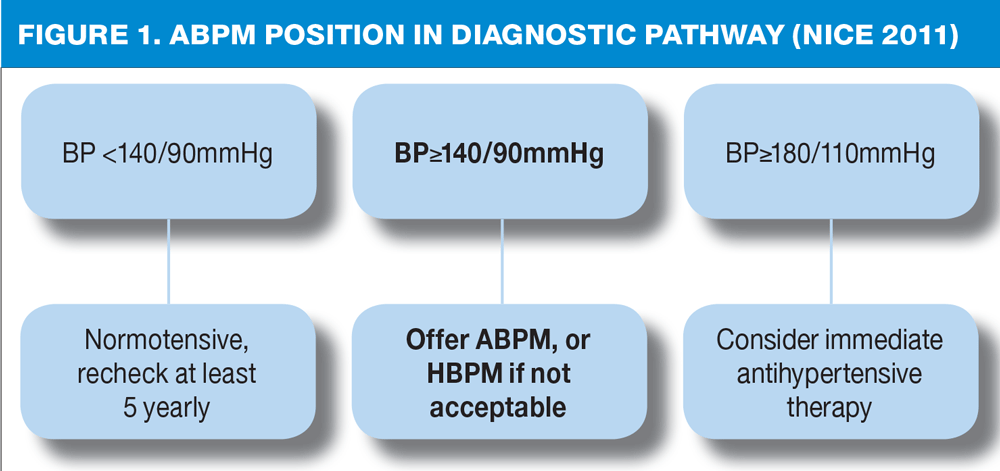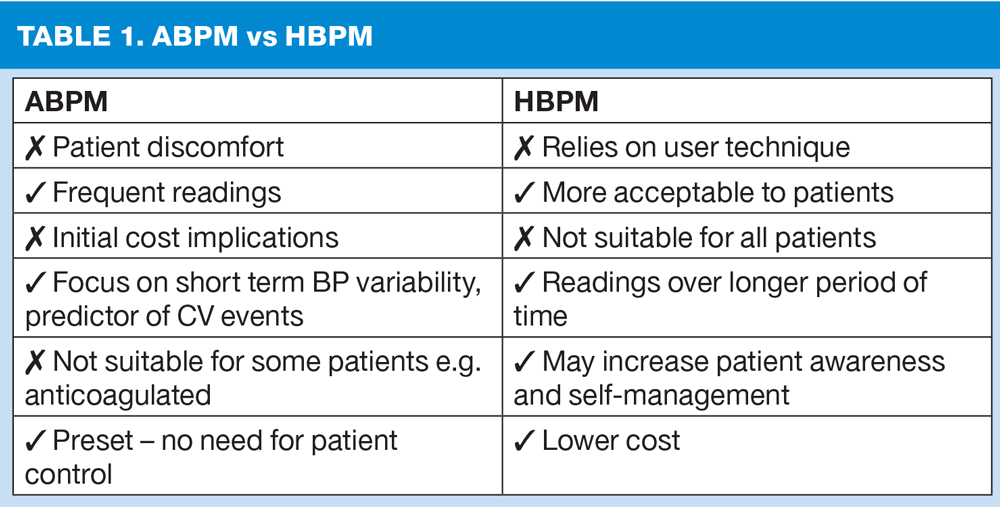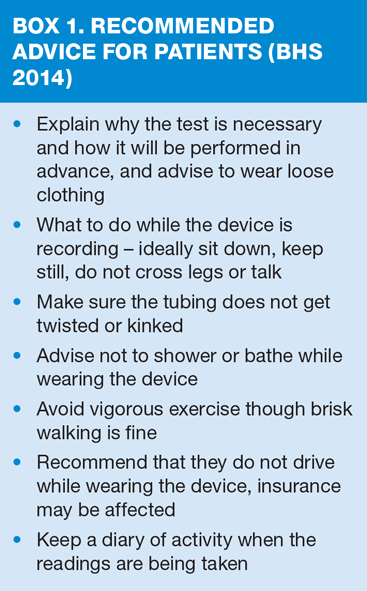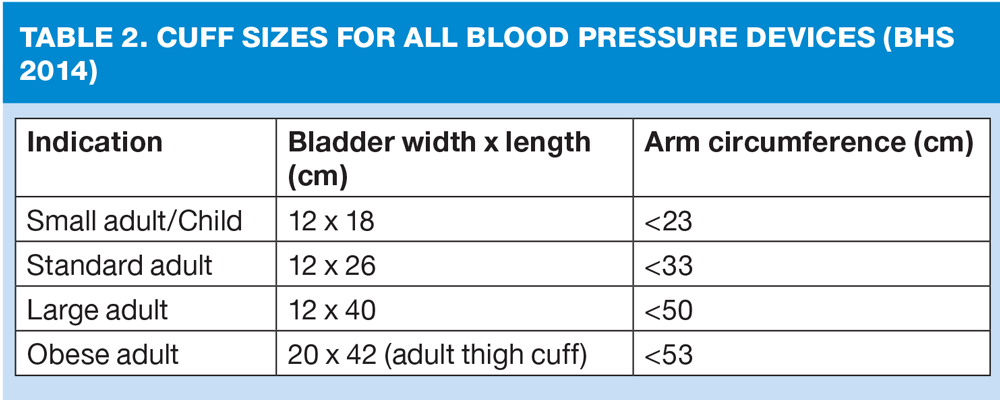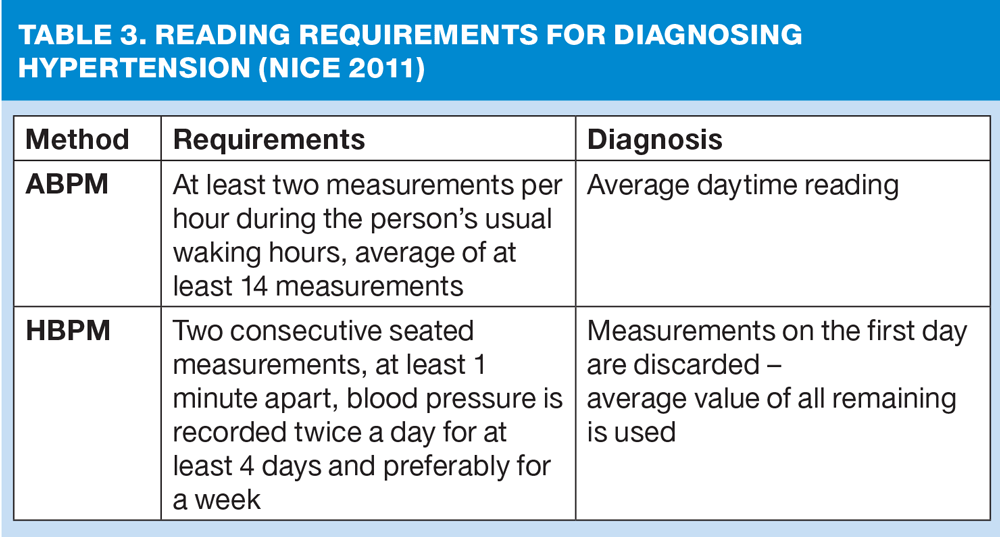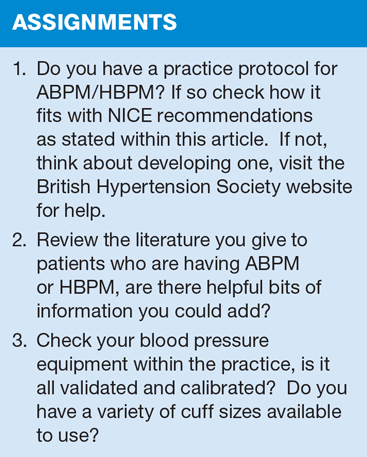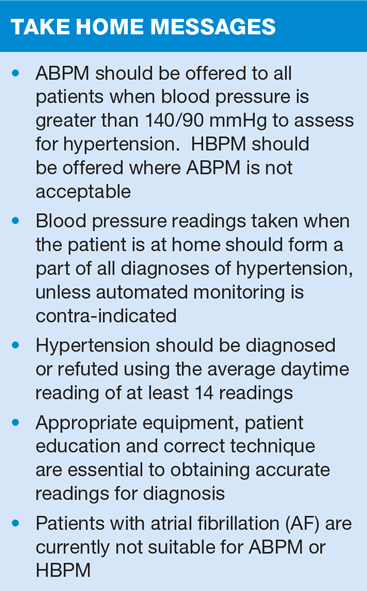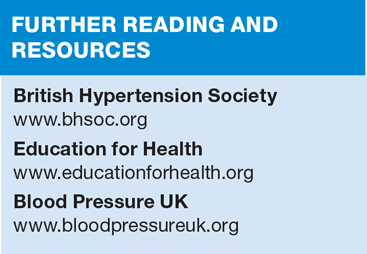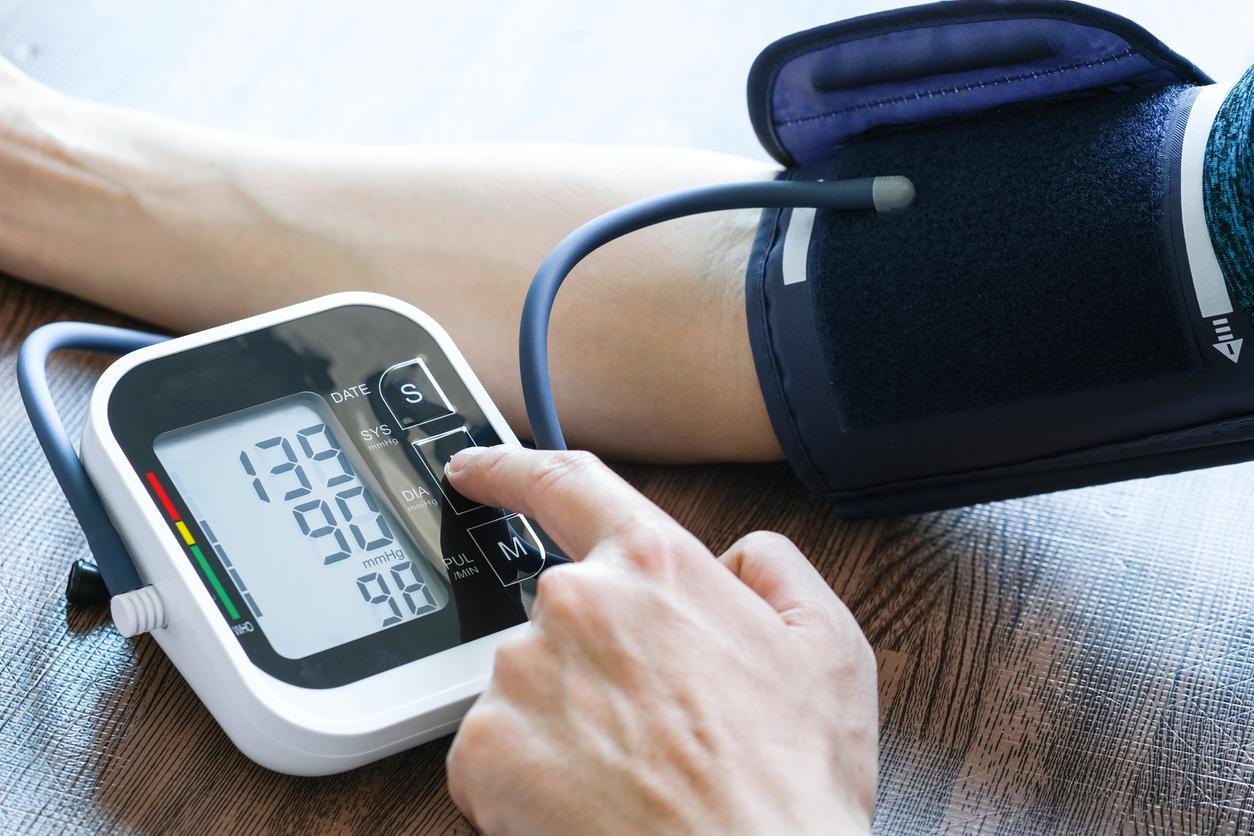
Ambulatory Blood Pressure Monitoring:are we getting it right?
Joanne M. Haws
Joanne M. Haws
RN MSc
Independent Nurse Consultant in Cardiovascular Disease
Clinical Trainer, Education for Health
The NICE 2011 guidelines for the management of primary hypertension in adults introduced the recommendation that all patients should be offered ambulatory blood pressure monitoring (ABPM) prior to a diagnosis of hypertension being made. The significant impact of this change in primary care has led to variable implementation; three years on, we revisit the topic and ask, are we getting it right?
Ambulatory blood pressure monitoring is the most accurate way of diagnosing hypertension in adults.1 The 2011 NICE hypertension guidelines and Quality Standards,2 published in 2013, recommend that people with suspected hypertension are offered ABPM to confirm the diagnosis (Figure 1), and that its use should reduce unnecessary treatment in those who do not have true hypertension. Furthermore ABPM is a better predictor of blood pressure related clinical events than standard clinic monitoring.3
For many years repeated measurement in the clinical setting over a short period of time has been the standard method of diagnosing hypertension and NICE believe this practice may have led to over-diagnosis and over-treatment of hypertension in some individuals.1 There are several key advantages of performing ABPM, most notably that the readings will give a more accurate profile of the individual’s blood pressure in their normal daily environment, avoiding any potential effects of the clinical setting.1 While there is no doubt that blood pressure recorded in the patient’s own home is a better predictor of cardiovascular risk than clinic readings alone,3 there remains significant variability in how this concept has been implemented within clinical practice.
GETTING THE SERVICE RIGHT
One often cited barrier to delivering an ABPM service is the issue of resources. Equipment acquisition itself can be costly and is added to by the need to train staff to fit the device, provide information for patients and retrieve and interpret results. ABPM is a cost effective way of diagnosing hypertension in primary care when appropriately implemented.2 NICE cost modeling demonstrates that projected savings from reduced consultations and unnecessary treatment will outweigh the cost of service delivery though the initial implementation costs still need to be found.3
It should be remembered that the diagnosis of hypertension requires an average daytime reading only, from a minimum of 14 measurements.1 This result can be obtained from a patient within an eight-hour period and while further readings, particularly night time readings, are clinically relevant they are not required to make the initial diagnosis of hypertension.4 Services where patients are currently wearing the device for a 24-hour period will not only reduce the number of patients who can be monitored within a set period of time but may also be giving patients unnecessary sleepless nights!
ABPM vs HOME MONITORING
ABPM is widely accepted as the gold standard investigation due to the wealth of evidence supporting its use as a diagnostic and predictive tool and its recording ability for large numbers of readings within a set period, giving an in-depth profile of the individual’s blood pressure.1 ABPM is not without limitation in terms of resources, both equipment cost and fitting time, and its acceptability to patients.5 The demand on an individual’s time, along with physical discomfort and the possibility of needing to repeat the test where readings were unobtainable or artefactual can lead to reluctance or even resistance to undergoing ABPM.
An increasingly acceptable form of monitoring, both to patients and clinicians is home monitoring (HBPM) where the patient, with appropriate advice on technique, can take their own readings with either their own or a loaned device over a period of time. The use of HBPM as an adjunct to clinic blood pressure monitoring is now included in most international guidelines,6 and is recommended by NICE as an alternative to ABPM where the latter is unavailable or unsuitable for the patient.1
For both ABPM and HBPM readings the clinician needs to take into account that readings should be expected to be lower than average clinic readings, and also that the evidence base for hypertension management is based on measurements obtained in the clinical setting. The most recent NICE guidelines give specific thresholds for ABPM and HBPM readings – unlike previous versions where clinicians were advised to add a nominal measure to home readings for comparison purposes.1
Although there is clearly more evidence for the use of ABPM in diagnosing hypertension the key factor is that there has been adequate assessment of blood pressure outside of the clinical environment to allow diagnosis to take place. This will only be possible with a sufficient number of reliable readings obtained through correct technique with a validated device. A summary of the benefits and limitations of both ABPM and HBPM can be seen in Table 1.
CHOOSING THE KIT
The key factors in choosing the right equipment, whether for ABPM or HBPM, are that is has been independently validated, regularly calibrated and maintained. For a full list of currently validated devices please visit the British Hypertension Society website www.bhsoc.org.
In addition to the device itself the user needs to ensure they are using an appropriate cuff size for the patient, a cuff that is too small or large will lead to over, or under-reading of the blood pressure. Appropriate cuff sizes for all blood pressure measuring devices can be seen in Table 2.
For routine maintenance between patients users should ensure the device is fully decontaminated in line with local infection control policy and has not been damaged or compromised in any way, e.g. been dropped or in contact with liquids.
FITTING THE DEVICE
A well-fitted device coupled with appropriate information for the patient will lead to successful acquisition of readings, reduce the need for repeated tests and ultimately to more timely diagnosis and treatment for the patient. Where patients have not been advised on appropriate clothing to wear for the duration of their monitoring, what the process involves and how they can help achieve successful readings there is a greater chance of failure.7 On the subject of failure, it is wise to ensure the device has adequate battery life to fulfill the required amount of readings. Device manuals or manufacturers will be able to advise on battery life and suggested replacement schedules.
As with all medical devices it is essential that the health care worker who is using the monitor has been fully trained and is competent in its use. An appropriate consultation slot should be made available for fitting the device allowing time for discussion and information sharing with the patient, including when they need to return the device and make a follow up appointment. A list of recommended advice for patients can be seen in Figure 2.
PATIENT EDUCATION
As well as information around the device itself and what the process involves the patient needs to be aware of the importance of using the correct technique to monitor blood pressure (Box 1). Although the patient will be in their own home there still needs to be a standardised procedure to obtaining blood pressure readings, particularly where the patient is in control of their own measurement in HBPM.
As would be expected in a clinical setting, the patient should be seated and relaxed with their arm supported and the cuff at heart level. They should not talk or move during the measurement and should keep their legs uncrossed. If the patient is responsible for recording their measurements they should ideally be provided with a diary sheet on which to do so and reminded of the importance of accurate recording.
If they are supplied with a device with an internal memory, which will store their readings, they should be advised of this and asked not to allow other family members or friends to use the device. While any additional identification of hypertension in the family will be useful, diagnosis and management based on another person’s blood pressure readings would certainly not!
WHAT ABOUT AF?
There is currently great emphasis in primary care on identifying patients with atrial fibrillation (AF) due to the substantial increase in stroke risk it carries for individuals.8 It has been postulated that the increased use of automated blood pressure monitors has led to a reduction in manual pulse palpation that could potentially detect AF. Furthermore such devices are not appropriate for use in patients with arrhythmias as the results are likely to be unreliable, therefore a manual method of monitoring blood pressure should be used.9 To date there are no ambulatory blood pressure monitors independently validated for use in individuals with AF therefore this should be avoided and clinical measurement using a manual monitor is indicated.1
READING THE RESULTS
A diagnosis of hypertension should be confirmed or refuted based on the average daytime reading.1 NICE diagnostic thresholds, using clinic and home based readings can be seen in Table 4. Most modern ABPM equipment will allow for the download of readings onto a practice computer and the average daytime reading will be automatically calculated. When using HBPM this can be calculated manually by adding firstly the systolic readings together and dividing by the number of readings taken, followed by the same process for the diastolic readings. The first day’s readings should be discarded to allow for the patients to having to familiarise themselves with the equipment.
It should be remembered that much additional clinically relevant information could be gained through ABPM alongside initial diagnosis. Significantly raised blood pressure on initial readings during fitting could suggest white coat hypertension; a lack of nighttime dip on a 24-hour reading could be a predictor of increased cardiovascular risk and significant dips in blood pressure could indicate a postural drop or over-medication in treated patients. The value of non-clinic blood pressure readings can be utilised at many stages of the patient journey beyond diagnosis.10
SUMMARY
Getting the practicalities of ABPM and HBPM right is essential to ensuring patients with possible hypertension are assessed in an appropriate, effective and timely fashion. Although ABPM is the preferred method in the majority of patients, the key factor is that blood pressure monitoring outside of the clinical setting features in the diagnostic pathway. If ABPM is not acceptable or appropriate for some patients HBPM provides a useful alternative that will fulfill the criteria of readings needed to make a diagnosis. Practice nursing teams are key to this process in primary care and could take the lead on ensuring the process and resources for this service are suitable for their patient population and are in line with relevant national guidance.
Getting the diagnosis of hypertension right is a vital step in assessing an individual’s risk of cardiovascular disease and offering them interventions to reduce their risk. Although not all nurses will hold responsibility for the management of hypertension in terms of prescribing they are the gatekeepers to diagnosis and treatment as well as ensuring patients are appropriately informed to monitor and manage their own hypertension where possible. Given the need for adherence to treatment and lifestyle modification in hypertension the importance of this role cannot be underestimated.
- Missed our article, Hypertension: why we measure it, why we treat it (Practice Nurse December 2014)? Catch up now at http://www.practicenurse.co.uk/index.php?p1=articles&p2=1067
REFERENCES
1. NICE. Clinical Guideline 127: Clinical management of primary hypertension in adults, August 2011. http://www.nice.org.uk/guidance/cg127
2. NICE. Quality Standard 28: Hypertension, March 2013. http://www.nice.org.uk/guidance/qs28
3. O’Brien E, Parati G, Stergiou G et al. European Society of Hypertension Position Paper on Ambulatory Blood Pressure Monitoring. J Hypertension 2013;31:1731–1768
4. Lovibond K, Jowett S, Barton P et al. Cost-effectiveness of options for the diagnosis of high blood pressure in primary care: a modelling study. Lancet 2011; 378:1219–30
5. National Institute for Health and Clinical Excellence. CG127: Costing Report. August 2011. London
6. McCormack T, Arden C, Begg A et al. Optimising hypertension treatment: NICE/BHS guideline implementation and audit for best practice Brit J Cardiology 2013; 20(suppl 1): S1–S16
7. O’Brien E. 24-h ambulatory blood pressure measurement in clinical practice and research: a critical review of a technique in need of implementation. J Int Med 2011;269: 478-495
8. Parati G, Stergiou G, Asmar R et al. European Society of Hypertension Practice Guidelines for home blood pressure monitoring. J Human Hypertension 2010;24:779–785
9. British Hypertension Society. Ambulatory Blood Pressure Monitoring Resources. http://www.bhsoc.org/resources/abpm/
10. NICE. CG180 Atrial Fibrillation: the management of atrial fibrillation, June 2014. http://www.nice.org.uk/guidance/CG180
11. Stergiou GS, Kollias A, Destounis A, Tzamouranis D. Automated blood pressure measurement in atrial fibrillation: a systematic review and meta-analysis. J Hypertension 2013 Jan;31(1):215-6
12. Marchiando RJ. Automated Ambulatory Blood Pressure Monitoring: Clinical Utility in the Family Practice Setting. American Family Physician. 2003;67(11):2343-2351
